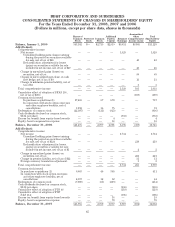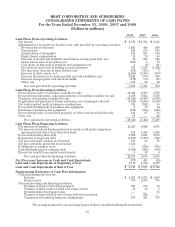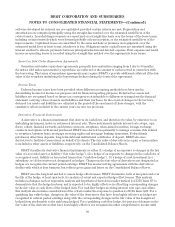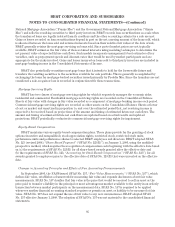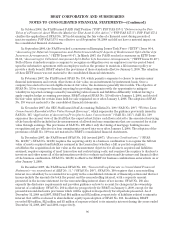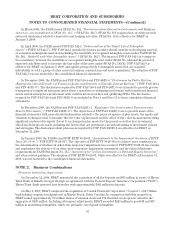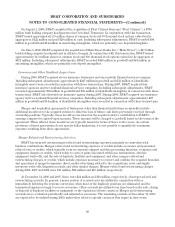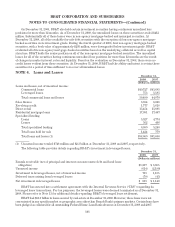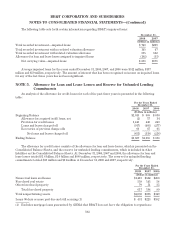BB&T 2008 Annual Report Download - page 93
Download and view the complete annual report
Please find page 93 of the 2008 BB&T annual report below. You can navigate through the pages in the report by either clicking on the pages listed below, or by using the keyword search tool below to find specific information within the annual report.BB&T CORPORATION AND SUBSIDIARIES
NOTES TO CONSOLIDATED FINANCIAL STATEMENTS—(Continued)
software developed for internal use are capitalized provided certain criteria are met. Depreciation and
amortization are computed principally using the straight-line method over the estimated useful lives of the
related assets. Leasehold improvements are amortized on a straight-line basis over the lesser of the lease terms,
including certain renewals which were deemed probable at lease inception, or the estimated useful lives of the
improvements. Capitalized leases are amortized by the same methods as premises and equipment over the
estimated useful lives or lease terms, whichever is less. Obligations under capital leases are amortized using the
interest method to allocate payments between principal reduction and interest expense. Rent expense and rental
income on operating leases is recorded using the straight-line method over the appropriate lease terms.
Securities Sold Under Repurchase Agreements
Securities sold under repurchase agreements generally have maturities ranging from 1 day to 36 months.
Securities sold under agreements to repurchase are reflected at the amount of cash received in connection with
the borrowing. The terms of repurchase agreements may require BB&T to provide additional collateral if the fair
value of the securities underlying the borrowings declines during the term of the agreement.
Income Taxes
Deferred income taxes have been provided when different accounting methods have been used in
determining income for income tax purposes and for financial reporting purposes. Deferred tax assets and
liabilities are recognized based on future tax consequences attributable to differences arising from the financial
statement carrying values of assets and liabilities and their tax bases. In the event of changes in the tax laws,
deferred tax assets and liabilities are adjusted in the period of the enactment of those changes, with the
cumulative effects included in the current year’s income tax provision.
Derivative Financial Instruments
A derivative is a financial instrument that derives its cash flows, and therefore its value, by reference to an
underlying instrument, index or referenced interest rate. These instruments include interest rate swaps, caps,
floors, collars, financial forwards and futures contracts, swaptions, when-issued securities, foreign exchange
contracts and options written and purchased. BB&T uses derivatives primarily to manage economic risk related
to securities, business loans, mortgage servicing rights and mortgage banking operations, Federal funds
purchased, other time deposits, long-term debt and institutional certificates of deposit. BB&T also uses
derivatives to facilitate transactions on behalf of its clients. The fair value of derivatives in a gain or loss position
is included in other assets or liabilities, respectively, on the Consolidated Balance Sheets.
BB&T classifies its derivative financial instruments as either (1) a hedge of an exposure to changes in the fair
value of a recorded asset or liability (“fair value hedge”), (2) a hedge of an exposure to changes in the cash flows of
a recognized asset, liability or forecasted transaction (“cash flow hedge”), (3) a hedge of a net investment in a
subsidiary, or (4) derivatives not designated as hedges. Changes in the fair value of derivatives not designated as
hedges are recognized in current period earnings. BB&T has master netting agreements with the derivatives
dealers with which it does business, but reflects gross gains and losses on the Consolidated Balance Sheets.
BB&T uses the long-haul method to assess hedge effectiveness. BB&T documents, both at inception and over
the life of the hedge, at least quarterly, its analysis of actual and expected hedge effectiveness. This analysis
includes techniques such as regression analysis and hypothetical derivatives under method 2 of DIG Issue G7 to
demonstrate that the hedge has been, and is expected to be, highly effective in off-setting corresponding changes
in the fair value or cash flows of the hedged item. For cash flow hedges involving interest rate caps and collars,
this analysis also includes consideration of the criteria under the response to question 2 of DIG Issue G20. For a
qualifying fair value hedge, changes in the value of the derivatives that have been highly effective as hedges are
recognized in current period earnings along with the corresponding changes in the fair value of the designated
hedged item attributable to the risk being hedged. For a qualifying cash flow hedge, the portion of changes in the
fair value of the derivatives that have been highly effective are recognized in other comprehensive income until
93




